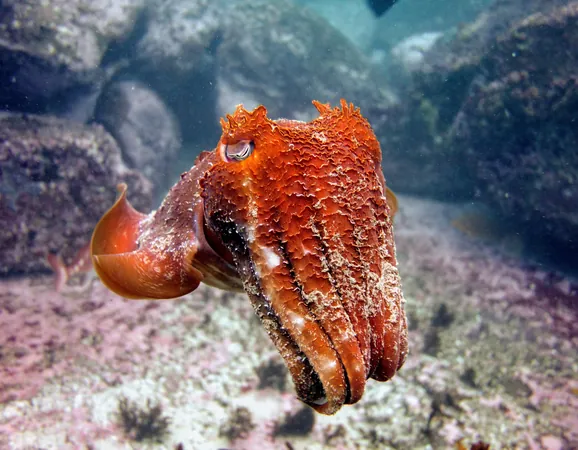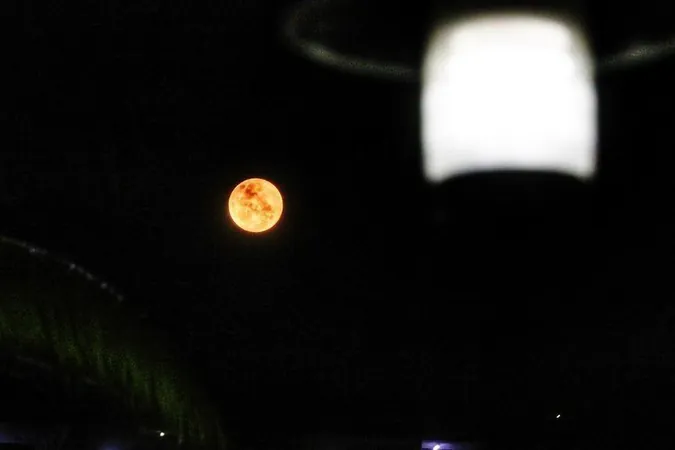
Cuttlefish Master the Art of Camouflage to Ambush Crabs in Southeast Asia
2025-04-03
Author: Li
In the vibrant and diverse waters of Southeast Asia, the broadclub cuttlefish has developed a remarkable technique for hunting crabs that blurs the boundaries between stealth and visual spectacle. This fascinating adaptation allows these intelligent cephalopods to surprise unsuspecting crabs using dynamic color-changing capabilities right before striking.
A recent study spearheaded by Dr. Matteo Santon from the University of Bristol's School of Biological Sciences sheds light on this mesmerizing behavior. Researchers have documented how cuttlefish utilize moving dark stripes down their bodies and arms just moments before launching an attack, effectively confusing their prey's perception of danger.
The Science Behind Cuttlefish Camouflage
Traditionally, camouflage has been viewed primarily as a means for prey to evade detection by predators, often focusing on animals that remain still. Dr. Santon and his team discovered that the cuttlefish's unique approach to camouflage challenges this notion, particularly in moving scenarios. While many predators exploit background motion to conceal their presence, cuttlefish have mastered the art of misleading their prey with dynamic patterns.
In controlled experiments, the research team observed that when the cuttlefish was approximately 3.2 feet away from its target, a high-contrast series of stripes began to flow down its body. This effect appears to interfere with the crabs' visual systems, creating a distraction that undermines their ability to detect an imminent threat. The crabs, which rely on visual cues such as looming shapes to signal danger, find themselves bewildered as the cuttlefish's stripes obscure those signals.
Dr. Santon noted, “The downward motion we observed in cuttlefish could be likened to visual 'static,’ clouding the predator's actual speed and position in the eyes of the crab, which has a limited ability to process visual information.”
Why Cuttlefish Are Masters of Survival
Most cuttlefish rely on ambush tactics, employing their fast-acting color-changing skin to adapt to various backgrounds. They not only camouflage themselves with the seabed but also manipulate motion in ways that confuse their prey. This flexibility is vital when hunting crabs, as cuttlefish can switch tactics based on their surroundings, whether they need to blend in with coral reefs or execute a dazzling display to captivate their target.
During the final moments of an attack, broadclub cuttlefish extend their arms and flatten their bodies to diminish the cues a crab would typically use to detect an approaching predator. The rhythmic flow of stripes across their limbs disorients the crab and masks the imminent danger.
Exploring Future Implications
This intriguing method of motion-based camouflage raises important questions about the evolutionary adaptations of cuttlefish and potentially other cephalopods. Researchers hypothesize that similar techniques may exist among different species of sea creatures. Furthermore, there is the possibility that certain crabs could become desensitized to these repetitive visual patterns over time, making them more vulnerable to cuttlefish ambushes.
Researchers are particularly keen to investigate the impact of environmental variables—such as light levels, water clarity, and competing predatory species—on the cuttlefish's camouflage displays. Understanding how these factors influence their hunting tactics may unlock new insights into the evolutionary arms race between predator and prey in complex aquatic ecosystems.
The groundbreaking findings are detailed in the esteemed journal *Science Advances*, marking a significant advancement in our comprehension of predator-prey interactions in marine environments.
As scientists continue to unravel the complexities of animal behavior and survival strategies, the cuttlefish stands out as a testament to the ingenuity and adaptability of nature. Will we discover more about their captivating camouflage techniques in the future? Stay tuned!

 Brasil (PT)
Brasil (PT)
 Canada (EN)
Canada (EN)
 Chile (ES)
Chile (ES)
 Česko (CS)
Česko (CS)
 대한민국 (KO)
대한민국 (KO)
 España (ES)
España (ES)
 France (FR)
France (FR)
 Hong Kong (EN)
Hong Kong (EN)
 Italia (IT)
Italia (IT)
 日本 (JA)
日本 (JA)
 Magyarország (HU)
Magyarország (HU)
 Norge (NO)
Norge (NO)
 Polska (PL)
Polska (PL)
 Schweiz (DE)
Schweiz (DE)
 Singapore (EN)
Singapore (EN)
 Sverige (SV)
Sverige (SV)
 Suomi (FI)
Suomi (FI)
 Türkiye (TR)
Türkiye (TR)
 الإمارات العربية المتحدة (AR)
الإمارات العربية المتحدة (AR)